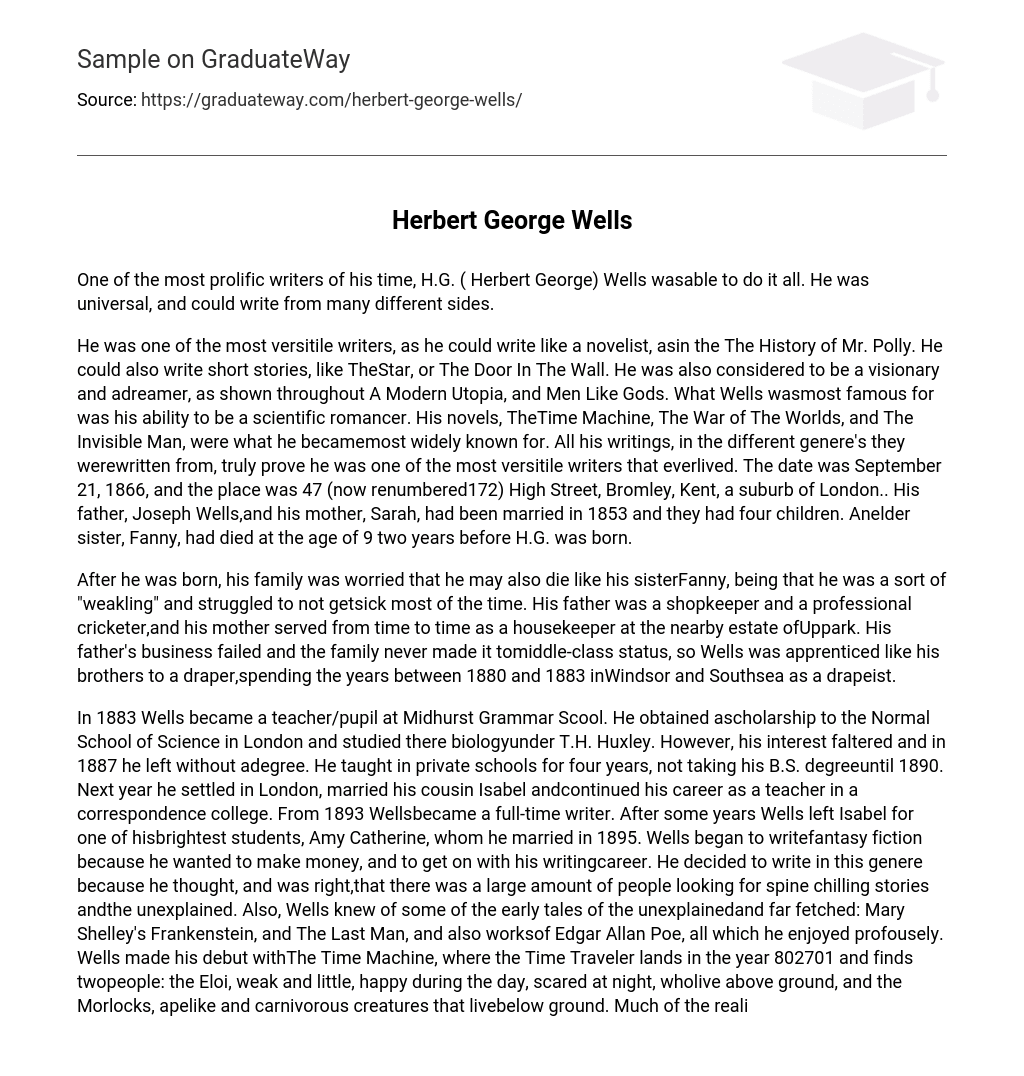One of the most prolific writers of his time, H.G. ( Herbert George) Wells wasable to do it all. He was universal, and could write from many different sides.
He was one of the most versitile writers, as he could write like a novelist, asin the The History of Mr. Polly. He could also write short stories, like TheStar, or The Door In The Wall. He was also considered to be a visionary and adreamer, as shown throughout A Modern Utopia, and Men Like Gods. What Wells wasmost famous for was his ability to be a scientific romancer. His novels, TheTime Machine, The War of The Worlds, and The Invisible Man, were what he becamemost widely known for. All his writings, in the different genere’s they werewritten from, truly prove he was one of the most versitile writers that everlived. The date was September 21, 1866, and the place was 47 (now renumbered172) High Street, Bromley, Kent, a suburb of London.. His father, Joseph Wells,and his mother, Sarah, had been married in 1853 and they had four children. Anelder sister, Fanny, had died at the age of 9 two years before H.G. was born.
After he was born, his family was worried that he may also die like his sisterFanny, being that he was a sort of “weakling” and struggled to not getsick most of the time. His father was a shopkeeper and a professional cricketer,and his mother served from time to time as a housekeeper at the nearby estate ofUppark. His father’s business failed and the family never made it tomiddle-class status, so Wells was apprenticed like his brothers to a draper,spending the years between 1880 and 1883 inWindsor and Southsea as a drapeist.
In 1883 Wells became a teacher/pupil at Midhurst Grammar Scool. He obtained ascholarship to the Normal School of Science in London and studied there biologyunder T.H. Huxley. However, his interest faltered and in 1887 he left without adegree. He taught in private schools for four years, not taking his B.S. degreeuntil 1890. Next year he settled in London, married his cousin Isabel andcontinued his career as a teacher in a correspondence college. From 1893 Wellsbecame a full-time writer. After some years Wells left Isabel for one of hisbrightest students, Amy Catherine, whom he married in 1895. Wells began to writefantasy fiction because he wanted to make money, and to get on with his writingcareer. He decided to write in this genere because he thought, and was right,that there was a large amount of people looking for spine chilling stories andthe unexplained.
Also, Wells knew of some of the early tales of the unexplainedand far fetched: Mary Shelley’s Frankenstein, and The Last Man, and also worksof Edgar Allan Poe, all which he enjoyed profousely. Wells made his debut withThe Time Machine, where the Time Traveler lands in the year 802701 and finds twopeople: the Eloi, weak and little, happy during the day, scared at night, wholive above ground, and the Morlocks, apelike and carnivorous creatures that livebelow ground. Much of the realism of the story was achieved by carefully studiedtechnical details. The Time Machine was a great success, and is the first ofhundred’s of writings Well’s produced. The Island Of Doctor Moreau (1896) is themost horrifying of Wells’s fantasies and one of the best written. The doctor isseeking to make animals half human by means of vivisectional surgery, thetransplatation of organs, and the pain involved is very vividly described.
Doctor Moreau suceede’s in making some of his man-animals talk and even read,but they tend to revert to the beast, so Moreau continues to try to get all theanimal out, and make a creature of his own. Moreau is then killed by hiscreatures, which continue to come to their demise, and finally all die off. Whenthe H.M.S. Scorpion visits the island, there is nothing alive there except for afew “white moths, some hogs and rabbits and some rather peculiarrats.” In the same year as his gorey fantasy The Island Of Doctor Moreau,he also published the light and cheerful novel The Wheels of Chance: A holidayAdventure. The Wheels Of Chance: A Holiday Adventure tells about a draper’sassistant (Wells was a drapers apprentice when he was younger, which is why itis believed he used a draper’s assistant as the occupation of the man) who setsoff on a cycling holiday and comes to the rescue of a maiden in distress. Thisbook wasn’t nearly as much as a success as The Island Of Doctor Moreau, but itshows the flexibility contained in his writings and thoughts. The year after H.G.
Wells wrote The Wheels of Chance, he returned to the fantastic and unrealisticgenre with The Invisible Man. It is about a man with a bandaged face, who wearsdark blue glasses and has a false nose. The man becomes frusturated and starts alife of crime and violence. He then gets into an ordeal with the police, andruns away from the town, and that is the end. Wells’s next novel, The War Of TheWorlds, which appeared in 1898, is probably his most famous work. It is aboutMartians, arriving from their planet in ten cylinders at twenty-four-hourintervals, and they devastate the whole country, especially London. The Martiansin his novel look like brain, floating in a brown liquid with nerves, thatinstead of eating, suck blood from other creatures.
They use spiderlike enginesto fight, and have the weapons to completely smother cities. The rest of thestory tells about how the humans were powerless against the Martians, and howthe Martians are able to take over whatever they want. In 1901 Wells wrote TheFirst Men On The Moon. This was nothing like The War Of The Worlds, even thoughthey both dealt with space. He used vivid descriptions of lunar scenery, and hewas quite close to what it looked like, as people saw in 1960 when pictures weresent back by American.
English Essays





